Windows 10: A Partner's Guide To The 10 Coolest Features
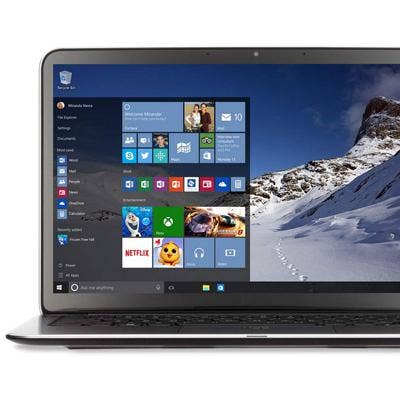
Windows 10 Is Nearly Fully Baked
Windows 10 will be available for PC and tablets starting July 29. Most of Windows 10's features are set. Microsoft is now spending much of its attention hunting down and stomping out bugs as well as adding tweaks and improvements to core features.
I've been using Build 10130 (released mid-June) and am appreciating Microsoft's attention to detail with new core features such as Start Menu and Cortana, and advanced features in the Spartan browser.
Here are 10 features of Windows 10 that you may not have heard of yet that make the OS shine.
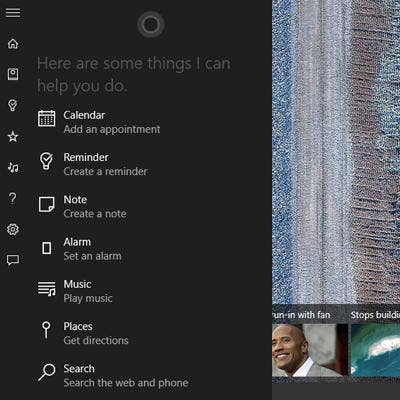
Cortana Gets Handy
By now you probably know about the Cortana digital assistant baked into the mobile and desktop version of Windows 10. Cortana, at least in early builds, will have a different range of functions on traditional desktops, tablets and smartphones.
So what will you be able to do with Cortana on a desktop? You can make appointments with Windows 10's Calendar app, set Reminders, create Notes and Alarms, play music stored locally on your PC -- all using voice commands. Using the phrase "Hey, Cortana," you can wake the digital assistant and ask it to hunt down directions from Point A to Point B on a map. Cortana can also perform a host of Bing searches, such as "What's the weather for today?" and "Who were Chris Pratt's parents?"
Some OEMs such as Toshiba will build Cortana buttons into their upcoming Windows 10 laptops. Other OEMs such as Lenovo are leveraging Cortana with their own technology to create hybrid search services. Lenovo is using its own ReachIt search technology in conjunction with Cortana to allow people to search all their Windows 10 devices at the same time for files and documents.
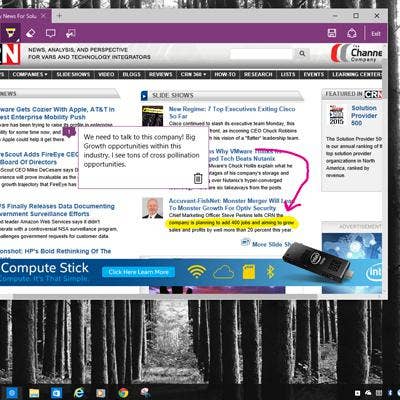
Spartan Browser's Nifty Features
Microsoft Spartan browser will be introduced with Windows 10. The biggest difference between Spartan and Internet Explorer is that it is lightning fast. But Spartan is no one-trick pony. The browser also sports a lot of fun features.
In the upper right-hand corner of the Spartan browser toolbar are edit tools. Edit functions include the ability to take screenshots and easily share or save Web pages with OneNote. The most unique function is the ability to annotate Web pages using either a digital marker or a highlighter. It's good for when you want to share a Web page and highlight text.
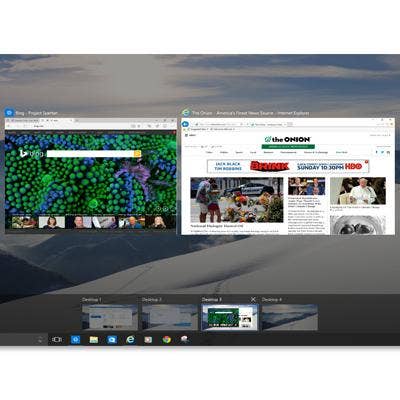
Virtual Desktops
Virtual Desktops allow you to spread different projects across multiple virtual desktops. The "desktops" are essentially like having two monitors. One monitor (or virtual desktop) can have your email, social media and instant messaging windows open and another desktop can have your video editing software layout, for example. With Windows 10, switching between desktops is a breeze. To navigate between Virtual Desktops, you can hit Windows + CTRL along with selecting either the left or right arrow keys.
To create a Windows Virtual Desktop, you can either click on the Task View program icon anchored in the system tray or just use the shortcut WIN + CTRL + D keyboard combination to create one on the fly. Select WIN + CTRL + F4 to close the desktop you're currently on.
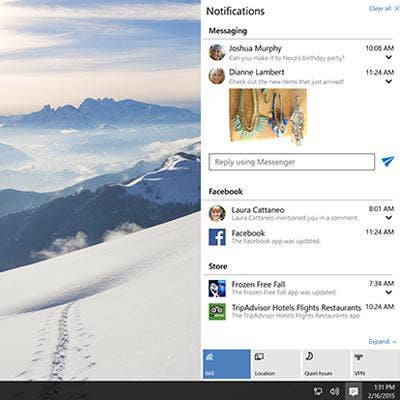
Notifications
In Windows 10, Microsoft has replaced all those information bubbles that mysteriously pop up and sink down from the lower right-hand side of your Windows desktop with an Action Center and a Notification Menu. Now when you click on a static information bubble in the lower right-hand corner of your Windows desktop, the Action Center will appear, revealing a Notification menu.
Here, you can view common settings, such as turning on/off Airplane Mode, or get at-a-glance access to Calendar items, most recent email subject lines and recent actions your PC has undergone.
The nice thing about Action Center is that you can go into Widows 10 Settings > Notifications & Actions and customize what your PC will alert you to.
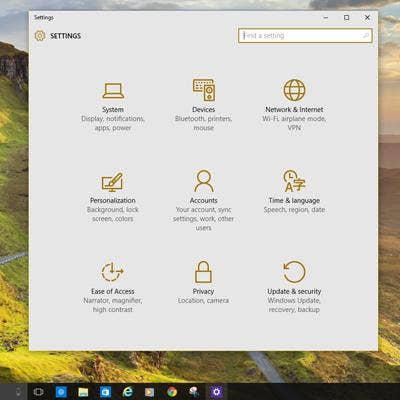
Settings App Replaces Charms, Yay!
Windows 8.1 caught a lot of flak for the way the OS relied on context-sensitive Charms that attempted to surface Windows Settings when and where you needed them the most. Microsoft, as a result of trying to serve both desktop and tablet users, created two separate Settings menus -- and user angst.
With Windows 10, Microsoft unifies Settings into one streamlined windows. The new Settings hub is very finger-friendly, creating nine Settings subcategories to drill down into to. Settings are available via two clicks directly from the Start Menu and also from the Action Center.
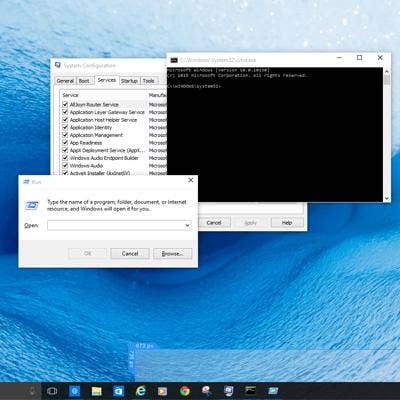
Power Menu Access
The Windows 10 Settings App doesn't replace Control Panel, it just made it a little harder to find. To easily access the Control Panel, along with a host of other tools such as Device Manager, Command Prompt and Network Connections, simply press WIN + X, or right click the Start button.
To access CMD/Powershell, just type CMD.exe in the Cortana search field. You can also hit WIN + R, which will pull the Run dialogue menu for easy access to the Powershell user mode, or access the System Configuration menu via "MSCONFIG." One side note: Ctrl-V does work inside the Powershell command prompt.

Windows 10 Ups Ante For Security Basics
Microsoft has added two-factor authentication support in Windows 10 along with a data loss prevention technology. In an attempt to separate corporate and personal user data across multiple Windows 10 devices, Microsoft will allow IT managers to encrypt corporate apps, data, email, Web content and other sensitive information on Windows 10 on desktop and mobile devices.
Admin will be able to set policies around which apps and corporate data can be accessed. And in an attempt to fend off malware and zero-day attacks, IT managers will also be able to lock down Windows 10 devices, allowing only users that have been digitally signed by a trusted Microsoft signing service to run specific apps.
The feature is called Device Guard and Microsoft already has support from Acer, Fujitsu, Hewlett-Packard, Lenovo and Toshiba, which have pledged to use the technology on their Windows 10 PCs and devices.
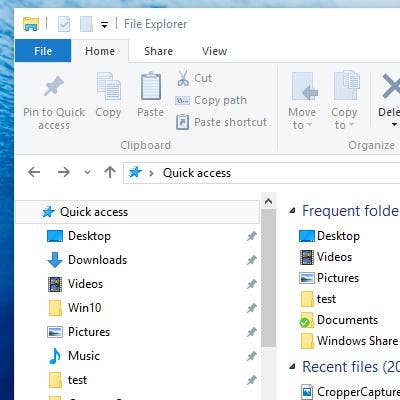
File Explorer Gets Folder Location Upgrade
In Windows 10, Microsoft has created a new default landing page for File Explorer. Here, you can view folders you have tagged as Quick Access. These folders and files are the most recent files you have opened or received.
You can also select what folders you want to have Quick Access to simply by right clicking on the folders within the Quick Access view of File Explorer and selecting "Pin to Quick Access."
Also added to File Explorer is automatic access to Microsoft OneDrive files associated with the Microsoft account you are logged on to with Windows.
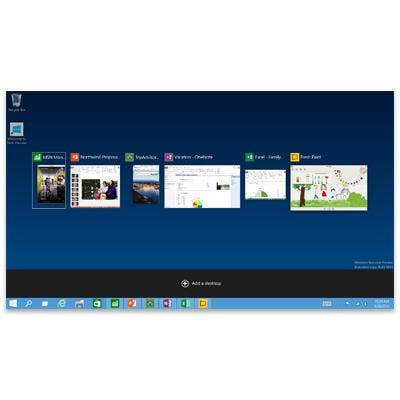
Task View
Task View is a close cousin to the Virtual Desktop feature in Windows 10. Both allow you to more neatly organize and conquer digital tasks. Just as Virtual Desktops allow you to separate your workspace, the Task View feature allow you to more neatly view open application and switch between them. Microsoft has anchored the Task View feature directly onto the Taskbar. When you click on the Task View icon, up pops each active app neatly resized in the middle of your screen. From this view you can either close an app or easily switch to another app. The menu option also allows you to generate a second Virtual Desktop.
To move an open application from one Virtual Desktop environment to another, first click the Task View button. Next you will see the thumbnail icons of all your running applications. Now right click on the thumbnail of the application that you want to move. Up will pop a menu option allowing you to select what number Virtual Desktop you want to transport the application to.
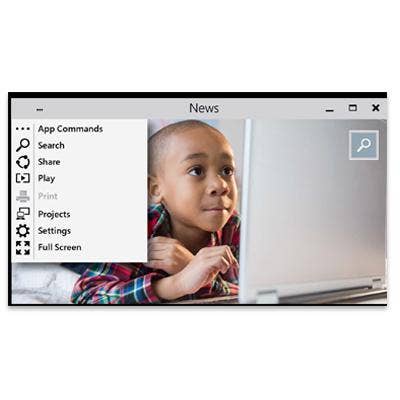
'Modern' Apps Vs. Continuum Apps
When Microsoft introduced Windows 8, it also introduced Metro or Modern apps, designed for finger navigation on touchscreen device. Facing criticism over ease of use of Modern apps on devices such as 2-in-1s -- where users switch back and forth from tablet to traditional desktop environments -- Microsoft decided to solve the problem by creating universal apps. These apps allow you to buy any software application from the Windows Store and feel confident it will run on all your devices -- desktop, laptop, tablet and even a Windows Phone.
But what about those holdover Windows 8 Modern apps that aren't universal? Those existing Modern apps, in Windows 10, will take advantage of the operating system's Continuum feature automatically. Click the app's options button in the upper left-hand corner of the program's window to do basic things like resize, make full screen, move, print or change the apps settings.